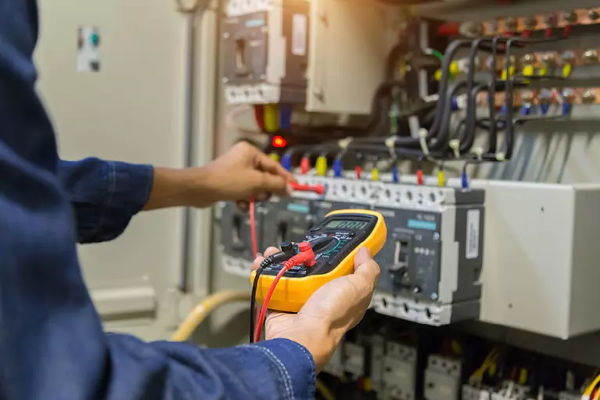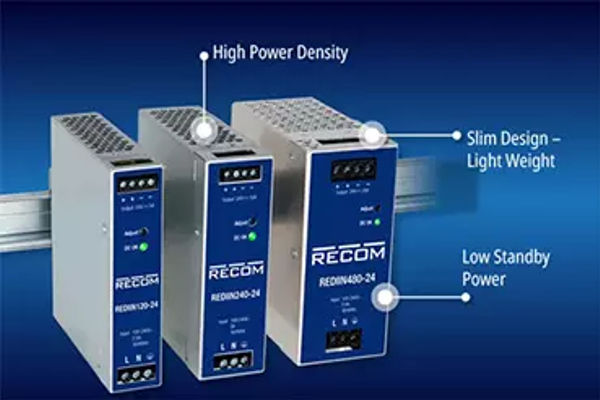DIN rail power supply offer several advantages over traditional power supplies. They are modular, easy to install, and space-efficient. They mount on a DIN rail, making them ideal for applications where space is limited or easy access to power is required. They come in various sizes, voltages, and wattages, catering to different needs.
Table of contents
- DIN rail power supply considerations
- RECOM’s DIN rail power supplies cover most DIN AC/DC requirements
- Conclusion
DIN rail PSUs are standardized and trouble-free to install. The basic requirements are fixed (single-phase or occasionally 3-phase input, a selection of standard outputs, and power ratings), so many of the decisions are simplified. In addition, the required input voltage operating range for most low or medium power AC/DC supplies is standardized worldwide to 90V AC – 264V AC, with only slight variations between countries.
That said, there are still a few specifications that can cause problems.
DIN Rail Power Supply Considerations
Operating temperature
Make sure that the power supply does not exceed its rated operating temperature. Temperatures outside of this range can cause a range of issues. High operating temperatures can cause performance to be derated; they also reduce operating life and increase the risk of malfunctions and failures.
Low temperatures can also cause performance problems, including increased output ripple and poor output regulation. In addition, changes in electrical characteristics at low temperatures may result in failure to start.
When selecting a DIN rail power supply, make sure that the unit can meet the requirements at the maximum operating temperature, taking derating into accoung if needed. Also check that the unit is guaranteed to start at the lowest operating temperature.
Very Long Power Cables
Can incur resistive losses that result in a voltage at the load that is below allowable limits.
There are several methods to counteract resistive losses, such as increasing the wire gauge, or increasing the output voltage (from 24V to 48V, say) and then using local DC/DC regulation at the load (PoL regulation).
Be sure to calculate the worst-case voltage drop and verify that the design still satisfies the requirement.
Capacitive or Inductive Loads
Supplying power to these types of loads can cause problems. Inductive loads including motors, solenoids, and relays can cause high voltage spikes; supplying capacitive loads can reduce the dynamic load response of the power supply, or lead to instability and increased output ripple. Make sure that the power supply can accommodate the types of loads required by the application.
Application-Specific Certifications
Applications in many fields require appropriate certifications for power supplies in the areas of safety and electromagnetic compatibility (EMC). Some examples include:
- IEC/EN/UL/CSA62368-1 is a product safety standard that classifies energy sources, prescribes safeguards against those energy sources, and provides guidance on their application and requirements. The goal is to reduce the likelihood of pain, injury, and property damage, including fire hazards. This standard applies to a wide range of technology products.
- IEC/EN/UL/CSA61010-1 is a safety standard that applies to electrical equipment used for measurement, control, and laboratory purposes. The 3rd Edition introduced a risk assessment procedure that covers equipment with human interaction such as displays or controls.
- EN55032/35 EN 55032 are standards related to electromagnetic compatibility (EMC) for multimedia equipment.
- EN 55032 (CISPR 32) defines tests to identify electromagnetic emissions from equipment with a rated AC or DC supply voltage not exceeding 600 V. The standard covers both radiated and conducted emissions.
- EN 55035 (CISPR 35) focuses on immunity; i.e., how well equipment withstands external interference. Manufacturers must assess all functions of a product for immunity. EN 55035 also specifies the testing and monitoring requirements to ensure compliance.
- EN 61204-3 specifies the electromagnetic compatibility (EMC) requirements for switch mode power supply (SMPS) units. These units are supplied by source voltages up to 1,000V AC or 1,500V DC, providing AC and/or DC output (except inverter outputs that establish AC mains). The standard ensures that these power supplies meet EMC criteria, minimizing interference and ensuring safe operation.
- EN 61000-6-4 specifies emission requirements for electrical and electronic equipment used in industrial environments. The standard covers the frequency range from 9kHz to 400GHz. EN 61000-6-4 Class B refers to a specific classification within EN 61000-6-4. Class B devices are suitable for use in residential areas and similar locations and have lower emission limits compared to other classes.
The designer must check the power supply for compliance with the applicable safety and EMC requirements.
RECOM’s DIN rail power supplies cover most DIN AC/DC requirements

REDIIN series applications include power supply solutions for measuring and testing equipment as well as industrial control and automation, power generation and distribution, and data and telecommunications systems.
The devices are available in standard DIN rail format at a width of 30mm (1.2“), 40mm (1.6“) or 56mm (2.2“) for the 120W, 240W and 480W versions respectively; all devices measure 123.4mm (4.86“) in depth by 123.6mm (4.87“) in height.
Operating temperatures range between -30°C and +70°C with convection cooling, with derating from +50°C and cold starting supported down to -40°C.
The convection-cooled units will operate full power from -30°C to +50°C (230VAC). It can operate in constant current mode, making it suitable for inductive and capacitive loads.
Electromagnetic radiated and conducted emissions are compliant to heavy industrial EN 61000-6-4 Class B Emission standard and EN 61000-6-2 Immunity standard. The product complies with environmental protection requirements as per RoHS Directive.
Conclusion
The DIN rail is the most popular mounting system in industrial control applications and components and modules compatible with it are widely available. Although specifying a DIN rail supply simplifies the task of the designer since many parameters are standardized, this blog has outlined the potential issues that remain.
RECOM offers a new family of DIN rail AC/DC power supplies that offer power outputs from 120W to 480W at a variety of voltages. Together they constitute a robust and cost-effective solution that meets the needs of numerous industrial and factory automation applications.




